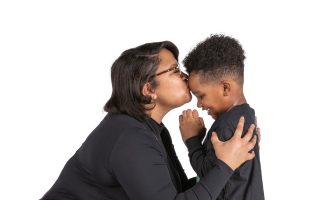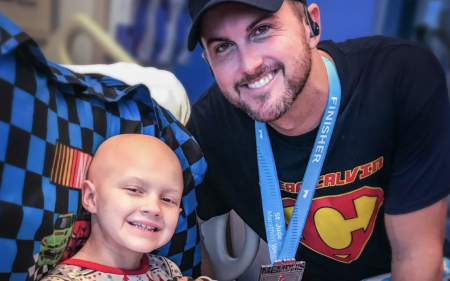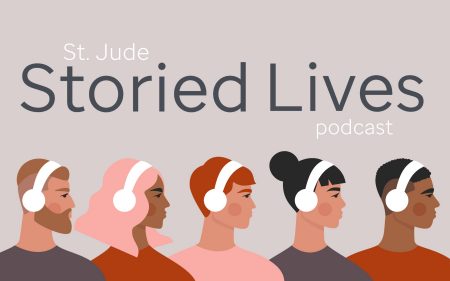
Newfound hope for Kamryn
The kindergartner is thriving thanks to advances in research and treatment pioneered at St. Jude.

February 25, 2023 • 4 min

Melissa always dreamed of having a son. They love their mamas best, she’d heard. And like a gift, Kamryn was born to her on Valentine’s Day.
When his hands were large enough, Kamryn held his mother’s face in them and pulled her close so she could properly hear him when he told her he loved her.
“Kamryn is so happy, so loving; he just lifts me up,” Melissa said.
“Can you imagine life without that?”
That fear hit her three years ago when Kamryn was diagnosed with acute lymphoblastic leukemia (ALL). He was a rambunctious, giggling 2-year-old when the daycare called saying he was fussy. This child was never sick, Melissa said. But on this summer day in 2019, Kamryn didn’t want to walk and spent the day whining. So, Melissa was worried.
A pediatrician initially diagnosed him with an ear infection, but when Kamryn seemed to feel even sicker and complained of pain along his legs more than a week later, Melissa took him to the emergency room.
This time, the doctors said it “looked like leukemia,” Melissa said, and referred her to St. Jude Children’s Research Hospital.
“I went numb when I heard that, but I kept thinking they’re not sure what it is and I’m going to hope for the best,” Melissa said.
Melissa was born and raised in Memphis. She’d heard of the research hospital and its work.
Over the years she’d encountered neighbors and friends who’d run races, volunteered and donated money toward the St. Jude mission to find cures for cancers and other catastrophic diseases in children.
Melissa had heard hopeful stories of children defying odds and relieved families; determined scientists and helpful doctors; and she prayed that Kamryn’s story would be part of this narrative.
When she walked onto the rose-hued campus on a blistering August day, she was wracked with a worry she could not shake: I might lose my son.
Doctors at St. Jude confirmed that Kamryn had ALL, the most common childhood cancer in the world.
They placed him on a treatment protocol called Total Therapy 17. It’s the first ALL protocol at St. Jude guided largely by analyses of the patient’s genes. Doctors and scientists sequence genomes of leukemia cells and normal tissue cells, then see how well the patient’s disease responds to the first rounds of therapy so that treatment can be individually tailored for kids to minimize side effects while eradicating the cancer.
“It was a dark moment, hearing leukemia, you know it’s cancer and all you can think about is death,” Melissa said, growing tearful remembering that day. “I was so sad and just overwhelmed about what was going to happen.”
But she found comfort and reassurance quickly, she said. First from a team of doctors who explained how the protocol was developed through research and testing over decades. And next, from a support team made of St. Jude nurses, social workers and therapists who answered questions about the treatment journey and its myriad effects on both kids and caretakers.
The protocol doctors offered Kamryn featured a mix of steroids and potent chemotherapy medicine, and it had been tested and refined 16 times since the 1960s. The treatment plan is born out of a sustained effort by doctors at St. Jude to continuously evaluate new and better ways of treating ALL.
Each study builds on the results of previous clinical trials, as well as discoveries made by St. Jude researchers working with scientists at institutions around the world.
Thanks to those collaborations, scientists at St. Jude are now learning more than ever about ALL. In fact, St. Jude scientists recently helped lead the nation’s largest comprehensive analysis of how genomes contribute to ALL, using samples from nearly 2,800 patients collected over a decade. They studied patterns of alterations in the genomes of leukemia cells and found new genes potentially responsible for the development of ALL.
Researchers found further evidence that ALL is not one single disease that affects every child the same way, but rather a collection of subtypes, some progressing differently in children. The subtypes have distinct alterations that pose different risks for children and support the need for more precise targeted treatment. These are the kinds of learnings that helped doctors at St. Jude tailor care for Kamryn.
“Initially, I was overwhelmed. But at St. Jude I got this newfound hope. I am so grateful for all the research and the support,” Melissa said.
It took more than two and half years of treatment, but Kamryn is now cancer free.
Melissa watched her son learn to take pills before learning to read, swim or ride a bike. She learned about how to comfort Kamryn as he received medicines intravenously, and she practiced different ways to manage the irritability Kamryn experienced after taking steroids. She was relieved when a nurse discovered music and singing would help Kamryn cope with the pain and fear he felt from needles and blood draws.
Today, 6-year-old Kamryn is a living, breathing symbol of progress: a testament to how St. Jude has steadily refined treatment protocols to boost survival rates for ALL from less than 5 percent when the hospital was founded in 1962 to about 95 percent today. And the advancements have improved patients' quality of life, too.
Kamryn’s memory is “impeccable,” his mother said. “He remembers every student, every teacher he meets, and they remember him.”
He is among the best and most prolific readers in his kindergarten class and particularly enjoys reading about dolphins. He’s starting to learn karate. He sings all the time, sometimes silly tunes he makes up with his mother to get ready in the morning and sometimes gospel songs for inspiration.
“I know I’m the mother and he should look up to me, but I look up to him,” Melissa said. “He handled everything with such grace.”







